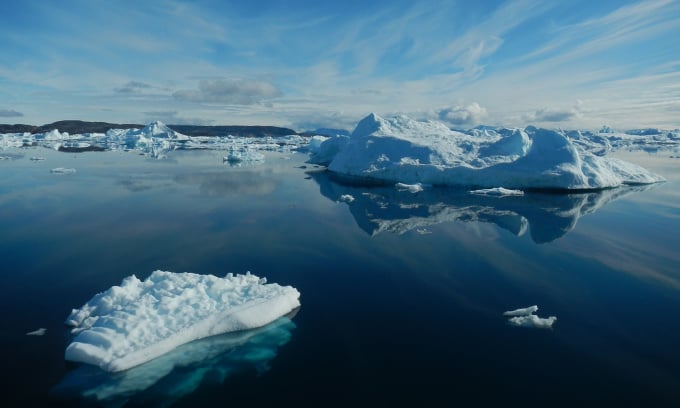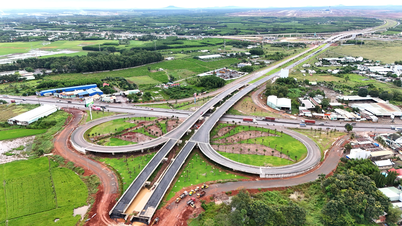About 117 million years ago, sea levels were about 210 meters higher than they are today, but this may not have been the highest level on record.

Icebergs on the southwest coast of Greenland. Photo: NASA/JPL-Caltech
Sea levels are rising due to climate change, which is melting glaciers and ice sheets, and increasing the amount of water in the oceans as the world warms. So have sea levels ever been higher than they are now, and when was their highest? According to scientists , sea levels were much higher in the past than they are today, but it is unclear exactly when they reached their highest levels.
Considering the past half-billion years, sea levels likely peaked 117 million years ago, during the Aptian period of the Cretaceous period. According to a 2022 study in the journal Gondwana Research , sea levels were about 210 meters higher than they are today.
"Over the past 540 million years, the highest sea levels occurred during the Cretaceous period, when dinosaurs walked the Earth," said geologist Douwe Van der Meer at Utrecht University, lead author of the study.
“For more distant times, it’s basically speculation,” said Jun Korenaga, a professor of Earth and planetary sciences at Yale University. According to research conducted by Korenaga, sea levels were higher early in Earth’s 4.5-billion-year history, when the first continents were forming and the Earth’s surface was almost devoid of dry land.
In the short term, sea level rise is closely linked to ice melt. For example, if the Thwaites Glacier in Antarctica melts, the entire West Antarctic Ice Sheet could collapse, raising global average sea levels by about 3.4 meters. In the long term, shifting continents and expanding seafloors also affect sea levels. Korenaga also believes that the early oceans contained more water than they do today. Since the Earth's formation, the oceans may have gradually seeped into the planet's mantle.
The last time the seas were higher than their present level was about 120,000 years ago, during the Last Interglacial Period. During this period, warmer climates melted ice in Antarctica, causing peak sea levels to be about 6 meters higher than their present average.
When Earth was completely or almost ice-free, sea levels could have been 10 times higher than during the Last Interglacial Period. “If you go back about 50 million years ago, when there was no ice in Greenland and Antarctica, sea levels would have been about 70 meters higher,” says Van der Meer.
Sea levels are highest when ice is at its lowest, but this is not a complete explanation for the high sea levels of the Cretaceous, when 30% of what is now dry land was underwater. Tectonic plates are also a factor.
Van der Meer estimates that sea levels were highest around the time the South American plate moved away from Africa, about 200 million to 100 million years ago. The plates were pushed apart as the South Atlantic Ocean formed in between. According to Van der Meer, the new oceans tended to be shallower than the oceans they replaced. During the Cretaceous, the combination of a lack of polar ice and shallow oceans led to the highest sea levels in about half a billion years.
Going back more than half a billion years, to a time when there is little geological evidence and scientific data, sea levels may have been very high. In a study in the journal Philosophical Transactions of the Royal Society A , Korenaga and his colleagues estimate that Earth’s surface originally held twice as much water as it does today.
Like ocean plates, water can circulate in and out of magma beneath the Earth’s crust. Korenaga’s calculations suggest that some of the water in the Earth’s surface oceans has been lost over billions of years. If his calculations are correct, even though sea levels continue to rise today, the peak may already be in the past. The earliest seas on Earth were higher simply because there was more water.
Thu Thao (According to Live Science )
Source link



![[Photo] Cat Ba - Green island paradise](/_next/image?url=https%3A%2F%2Fvphoto.vietnam.vn%2Fthumb%2F1200x675%2Fvietnam%2Fresource%2FIMAGE%2F2025%2F12%2F04%2F1764821844074_ndo_br_1-dcbthienduongxanh638-jpg.webp&w=3840&q=75)




























































![[VIMC 40 days of lightning speed] Da Nang Port: Unity - Lightning speed - Breakthrough to the finish line](https://vphoto.vietnam.vn/thumb/402x226/vietnam/resource/IMAGE/2025/12/04/1764833540882_cdn_4-12-25.jpeg)















































Comment (0)